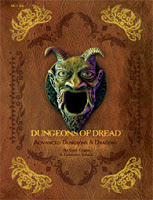
Lawrence Schick, in his introduction to module S4 in the WotC reprint volume “Dungeons of Dread”, tells us this interesting tidbit about the module and how it fit into Gary Gygax’s original conception:
“S4 The Lost Caverns of Tsojcanth marked the end of the S series—and rightly so, because despite being based on a gilded-hole dungeon originally designed for a tournament in 1976, its updated version really belonged more to the ’80s campaign-setting school of design than to the wild-and-woolly ’70s. S1 through S3 were standalone modules that could be easily dropped into any DM’s campaign, but Tsojcanth is firmly based in Gary’s World of Greyhawk. Indeed, there’s evidence that Gary considered Tsojcanth part of a longer Greyhawk campaign, placing the adventure between T1–T4 The Temple of Elemental Evil and WG4 The Forgotten Temple of Tharizdun. (By this reckoning, The Village of Hommlet, The Temple of Elemental Evil, and Tsojcanth are thus the “lost” WG1 through WG3 modules.) So, Tsojcanth was published in the S series because it got completed out of order, but was too good to delay.”
(Thanks to Mortellan for pointing that out on his Greyhawkery blog)
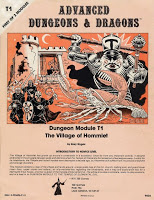 Now, this got me thinking of how, exactly, one might transition from the purported WG2 (Temple of Elemental Evil) to WG3 (Lost Caverns of Tsojcanth). If, as Schick claims (and The Acaeum concurs), they were originally supposed to be part of a larger campaign arc, taking adventurers from Hommlet to the Temple of Elemental Evil to the Lost Caverns of Tsojcanth and ultimately to the Forgotten Temple of Tharizdun, just what was the narrative connection?
Now, this got me thinking of how, exactly, one might transition from the purported WG2 (Temple of Elemental Evil) to WG3 (Lost Caverns of Tsojcanth). If, as Schick claims (and The Acaeum concurs), they were originally supposed to be part of a larger campaign arc, taking adventurers from Hommlet to the Temple of Elemental Evil to the Lost Caverns of Tsojcanth and ultimately to the Forgotten Temple of Tharizdun, just what was the narrative connection?
Now, some of those connections are relatively easy to explain. The Village of Hommlet was specifically written to lead in to the Temple of Elemental Evil. NPCs and plots are common to both, and they are geographically next to one another. That one’s easy.
The narrative connection between the Lost Caverns of Tsojcanth and the Forgotten Temple of Tharizdun are a little harder to unravel. Certainly the mechanics of the connection are easy enough; the gnomes in one of the side-treks in Lost Caverns direct the adventurers to the Forgotten Temple to clear out a band of pesky norkers. But in a narrative sense, having the Forgotten Temple as the capstone of the campaign arc seems an odd choice. Perhaps– just perhaps– a narrative thread might present itself if we pursue the discussion. Let’s put that one on hold for the moment.
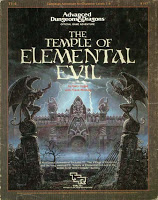 That still leaves us with the connection between the Temple of Elemental Evil and the Lost Caverns of Tsojcanth. The module as published isn’t much help; the Margrave of Bissel simply summons the PCs and sends them into the Yatil Mountains to find the caverns and loot them. But was there some narrative connection in the original conception as speculated upon by Schick?
That still leaves us with the connection between the Temple of Elemental Evil and the Lost Caverns of Tsojcanth. The module as published isn’t much help; the Margrave of Bissel simply summons the PCs and sends them into the Yatil Mountains to find the caverns and loot them. But was there some narrative connection in the original conception as speculated upon by Schick?
I think so, and that connection is Iuz, and two factors point to this as the narrative bridge between the two.
First, according to the Secret History of the Temple (of Elemental Evil) that the whole elemental evil sect was a ploy concocted by the demon princess Zuggtmoy, and that Iuz came on soon after its inception as an almost-equal partner in the scheme. Iuz is also deeply involved in the attempts to free Zuggtmoy and restore the Temple to its former glory, especially through agents such as Hedrack (“the mouth of Iuz” as he is known) and Barkinar.
Second, the Lost Caverns were of import precisely because they were used as a base by the witch-queen Iggwilv. It is her magical treasures that the Margrave of Bissel wants to keep out of the hands of his enemies in Ket, in particular the Lanthorn. And, of course, Iggwilv is the mother of Iuz.
Now, this is all speculative, but building off Schick’s statement that some sort of meta-narrative was originally planned for the series, Iuz becomes the narrative connection between ToEE and LCoT. That connection was never, obviously, written into the modules as published, but we can speculate based on what is there.
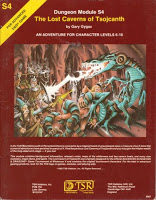 We know from ToEE that Iuz is trying to help Zuggtmoy escape imprisonment under the Temple and generally help the Temple itself to rise. From LCoT we know that Iggwilv, the mother of Iuz, was known for her deep knowledge of demons and demonkind, as well as her own stockpiles of magical might.
We know from ToEE that Iuz is trying to help Zuggtmoy escape imprisonment under the Temple and generally help the Temple itself to rise. From LCoT we know that Iggwilv, the mother of Iuz, was known for her deep knowledge of demons and demonkind, as well as her own stockpiles of magical might.Perhaps Iuz believes that something his mother had could help free Zuggtmoy. This could be a hitherto-unknown spell in her spellbook, a function of Daoud’s Wondrous Lanthorn, the aid of some demon or other extra-planar creature that Iggwilv had in her thrall, etc. The PCs, having (presumably) stopped the initial attempt to free Zuggtmoy in the Temple of Elemental Evil, would then set off to stop the agents of Iuz from getting access to Iggwilv’s treasure. In essence, Iuz replaces Ket, and Veluna/Furyondy (perhaps even the kidnapped Prince Thrommel himself) replaces the Margrave of Bissel.


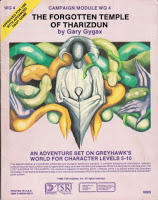







Well done Joe, you bring up alot of good possibilities to tie Tsojcanth (an underrated module I'm sure) into a much grander story arc.
Another adventure I'm sorely lacking knowledge in, is the Return to the TOEE. I wonder if the writer/s of Return had something like this in mind?
This is why I keep coming back to this blog. I love the Greyhawk deep dives and exploration into the history of this world.
Plus I love these adventures and love hearing about them.
I tend to think not, @mortellan. Based on how much he flat-out changed and contradicted what was in ToEE, I don't think Monte Cook spent much time thinking about the deep intricacies of the material before he wrote RttToEE.
Awesome speculations!
My reading of T1-4 is a bit different than yours: I see Iuz as not actually very keen on freeing Zuggtmoy. Take this passage: "Iuz is satisfied with things as they stand […] he is doing a few things with which Zuggtmoy's presence might have interfered." (pg. 95) This also provides a direct justification for Iggwilv's meddling: she wants Zuggtmoy to interefere with her son's plans.
Let's assume Iuz understands this, and put it together with the following: "If he could somehow free Zuggtmoy, she would certainly be much in his debt. At the same time, she would be seething with a lust for revenge against those who imprisoned her." (T1-4 pg. 29) Maybe Z's lust for revenge is incompatible with the specific plans Iuz is formulating? So perhaps what he really wants isn't just to free her, but also to control her once she's freed. In the Caverns, the means by which Iggwilv controlled Graz'zt can be discovered!
The Schick tidbit is an unexpected restoration of a welcome state of affairs; certainly much better than that shoehorned T -> A -> GDQ sequence from the 1985-86 supermodules, especially given that T1-4 implies that it follows GDQ ("having just learned of the sharp check dealt to Lolth", pg. 29)
Incidentally, I could never really make sense of the Temple timeline: Zuggtmoy is bound in 569CY after Emridy Meadows (Folio pgs. 5, 8), and Iuz is freed in 570CY (Folio pg. 12). The year 505CY is usually cited for Iuz'z capture at the hands of Zagig; I'm not sure where that date crops up first, but going strictly by the Folio the capture must be before 513CY, since the "Rise of the Horned Society" (pg. 5) presumably takes place in the subsequent power vacuum.
So when are Zuggtmoy and Iuz supposed to have collaborated on the whole Temple scheme? T1-4 is explicit that Iuz hopes thereby to check the "growing power of the Horned Society" (pg. 29). So the collaboration takes place after Iuz'z capture and before Zuggtmoy's. It can't have happened (never mind how it would have) during Iuz's captivity because after Emridy Meadows "Zuggtmoy was bound in the dungeons, but Iuz remained free" (T1-4 pg. 29 again).
Is there an accepted resolution for these apparent contradictions?
Insightful article, it makes sense. I should give Tsojcanth another look-see.
There is also this, hidden within the mind of Senshock, which is so sensitive that Iuz slays him to prevent any further leaks: "Iuz is working against the Scarlet Brotherhood, and seeks Zuggtmoy (whose location is unknown even to him) and his mother Igwlf (believed lost in the great Abyss) to aid him in his task." (T1-4 pg. 99) So possibly Iuz hopes to find in the Caverns some means to locate his mother.
Another fascinating piece of information. Whilst I had heard before that S4 was originally part of the WG series, I had no idea that it was intended to form an arc. I think the ideas that are proposed are very interesting, although I would be very interested also to see how the EEG (which I accept was never worshipped in the ToEE) fitted in with both this arc, and the GDQ series.
There is some overlap between Lolth and the ToEE, with her minions involved (e.g. Lareth, and the 'visiting Dark Elves). I recall that EGG mentioned in the past that he had a link between the ToEE and Drow Modules in mind. Do we now see a potential double-arc starting with GDQ, with a new arc picking up afresh after?
It is mind-bending, trying to make these discordant threads connect, and yet so addictive. I am inspired by everything you have done.
To me, it seems unlikely (given the timing) that Iuz had anything to do with the ToEE construction, and it seems the less convoluted explanation is that its intended devotion to the EEG was genuine (in the mind of Gygax). Everything else seems an embellishment added after the fact.
The pair of demon Queens (Zuggtmoy and Lolth) may have been have once been thralls of the EEG before his/its banishment outside of existence, and apparently like the new status quo better with them on top. It may be that Zuggtmoy was suppose to actually be Lolth when T1 was first published—but perhaps not, there where always a plenitude of demons/gods/demigods in the original works.
The only motivation for Iuz to get involved seems to be his mother. Iggwilv's trapped in the Abyss and he seeks a demon ally to reach her—to what end…who knows?
The Tsojcanth connection is again with Iggwilv and demon-control. But what exactly? A puzzle there.
Lastly, the much speculated is Tharizdun (also a mysterious vanished evil god) the EEG? As much as I really want it to be otherwise, I have to side with "no". The EEG is a tentacle-ly Cthulhu-inspired horror, where-as Tharizdun strikes me more like Morgoth in the Silmarillion—less of a destroyed and more of a dictator.
Please keep turning these puzzles-piece over in your keen mind. This is way too much fun.